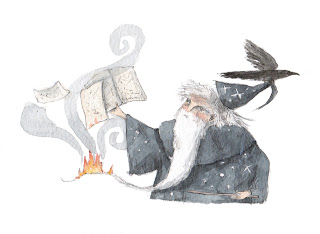Olaf Ratbeard (927-974)
When Ratbeard arrived on the Suffolk coast from Denmark in the freezing Godless winter of 941, none of his compatriots sensed his dark otherworldly powers, but Olaf always felt a little different to the other men in his band of bloodthirsty Viking marauders. One sign was that after slaughtering Saxon families Ratbeard would always hang back and be more reluctant than his peers to cut off the testicles, tongues and penises of their victims. The other was that, when he was angry, his eyes would flash green and purple. He first noticed this when he saw his reflection upon washing his ears in the Great Ouse, shortly after a notorious womaniser called Ragnuld had stolen his girlfriend: a gentle flower named Vigdis whose radiant beauty could not be blighted by the fact that all but one of her nine remaining teeth were black as Byzantine peat.
But Ratbeard was a generally mild character who rarely got riled in public and it wasn’t until his 20th birthday, when he banged his funny bone especially hard on a tree stump, that anyone else actually noticed his psychedelic eyes. “Behold! This man is a living devil!” shouted his boyhood nemesis Asmund, who’d been walking only a few paces behind him at the time. This was generally viewed as an overreaction, but soon Ratbeard’s reputation as a wise man and mystic spread and fellow residents of the village where he’d settled, just outside of York, would come to him for advice. “I am very torn,” Fiske, one of the band’s most headstrong young shitheads, asked him. “I respect Haldor, but I also like his dog, Uff, and am having great difficulty in suppressing my urge to steal him in the dead of night.” None of Ratbeard’s responses to dilemmas like this – all of which involved him counselling fellow members of his community not to run off with their compatriots’ pets, livestock, husbands or wives – appeared exactly visionary to him, but they seemed to suffice and gained him even more respect. His colourful eyes were also very useful when it came to confrontations with rival Viking pillagers. One of his friends would simply kick him hard in the shins and, having seen the terrifying otherworldly effect of this, the rivals would flee, mumbling some cliched old guff about Valhalla.
Ratbeard had always felt something a bit tingly in his fingertips when he was angry but it wasn’t until he was deep into middle age, not long after his 24th birthday, that he decided to reach within himself and test the extent of his magic powers. After all, he had no tutor, and his grandfather, from whom he’d genetically inherited his supernatural streak, had been beheaded and kicked into a quarry by his grandma when Ratbeard was just three months old. One night, though, after an unusually hard and uncalled for shin injury at the hands of Asmund, he went to take some quiet alone time in the forest during a fierce storm. As if guided by an unseen force, Ratbeard raised his hands to the sky and let out a piercing cry in a language he did not know had been lurking inside him. The world’s roof turned blacker than ever before, trees bowed back horizontal against the ground, and the night screamed aural hellstench and fuckgasms into his ears. Thirty seconds later, when all was again calm, he noticed that above him, a cow who’d been phlegmatically chewing the cud nearby now resided in the upper branches of a great Oak tree. Ratbeard was confused, although evidently not quite as confused as the cow itself. He attempted his rudimentary form of magic in a series of other storms from 952 to 973, but all that happened, each time, was that a nearby cow ended up in a tree. This proved to be of little use to anyone, with the exception of one time during the infamous failed cattle raid of 968 by Erik Thudspear, a notorious livestock thief from the opposite side of the River Nidd.
Winky Wanky Wizard (1512-?)
Zero concrete material evidence remains of the life of Winky Wanky Wizard, and there is no actual record of one of his spells, although his life is chronicled to some extent in the nursery rhyme of the same name which, after being hugely popular during the 16th, 17th and 18th centuries, all but vanished during the middle of the 19th, due to what stern repressive Victorians viewed as its unsuitability for infants. It tells of Winky Wanky Wizard, the one-legged wizard born in 1512 who, having been employed by the King (Henry VIII, one presumes) to ward off Spanish and French invasion by conjuring seamists and giant hellstallions, instead ran off – albeit quite slowly – with his advance payment and used it for a sequence of wild and eclectic encounters with prostitutes around Britain and Ireland, each of which is described in graphic detail. Late sixteenth and early seventeenth century versions of the rhyme are allegedly darker still, due to being accompanied by an illustration of what has been described as “a gaunt, seaweed-haired man who hath a nose but not a face”.
Kathy Kittlewell, aka The Suffragette Wizard (1880-1941)
Kittlewell first came to prominence in her late teens, where she was seen making tankards of beer levitate in various East London pubs and punishing any man who referred her as a “witch” by stripping him from the waist down using just her thermonuclear brain waves and sending him into a hyperactive jig trance, giving strangers the opportunity to throw beer and ashtrays at him until he recanted. By the age of twenty five, Kittlewell’s wizarding skills had advanced to the extent that, on one weekend, she managed to move a hill in north Wales to the Cambridgeshire Fens just by saying “Advance!” and blinking twice. A fortnight later, feeling guilty, she replaced it.
This was an indication of Kittlewell’s fundamental kindness, but also perhaps that her interest in wizardry was already beginning to wain. From 1908 until a decade later, when women were finally awarded the vote in Britain, she was an influential, though self-effacing, member of the women’s suffrage movement, getting involved with hunger strikes and throwing herself under a large badger ridden by King Edward near Sandringham, with near-fatal consequences. Kittlewell might have been a talented wizard, but her heart was in social change and women’s rights and it was here that she made the most difference and left her true mark on the world. It was only late in life that she wondered if she might have used some of her wizarding prowess to effect that social change by, say, turning an influential member of parliament into a newt until he agreed to the demands of her and her cohorts. This says a lot about Kittlewell’s nature, which, while formidable, selfless and brave, was not always practical.
Ken Talbot (1939-96)
Talbot rose to prominence during the mid-1960s, when he was a familiar face on Bedford High Street – or “The Real Carnaby Street” as he tended to call it – and renowned for his velvet capes, long flaxen hair, large hats and the dab of glitter he always wore on his left cheek. Before long he was immortalised in the song ‘Ken Talbot’ by the whimsical, LSD-influenced Luton-based one hit wonders Jeremy’s Party and even invited to stand on stage, a slightly sinister, unmoving way, at a couple of their gigs. Many will remember the track’s flute-dominated verses and central refrain, “Ken Talbot/That freak can do magic”, which rang out in many of the most fashionable night spots of Bedfordshire for one heady week in 1967.
Talbot’s career high point came during 1968, when several of the era’s top bands, including The Who, The Beatles and The Rolling Stones, almost came to his house in Dunstable for a black magic be-in. But as with so many who lived the optimistic high life during the 60s, the 70s were a dark time for Talbot, involving a drug trafficking charge and the loss of his job in his local post office. He resurfaced in the mid-80s, working for a homeless charity, where his younger colleagues scoffed at his stories of performing “spells” and helping John Lennon look for his mind under the table of the Horse And Groom in Bedford. Nonetheless, he existed contentedly, if humbly, in his second career until 1996, when he was eviscerated by a lightning bolt shot from the eyes of a 3000 year-old warlock in the settling of a feud stretching back to Talbot’s early years living on the distant underplanet Kagnathian.
Parking Bob (1947-present day)
Few modern day wizards have looked the part more perfectly than Parking Bob, but, as he would be the first to tell you, the wizard life has been a bumpy ride for him. Having first discovered he could make fire come out of the palms of his hands not long after puberty kicked in, many difficult years followed, involving a self-enforced abstinence from masturbation, the incineration of countless favourite books, the disgruntled departure of his magic raven and, tragically, in 1992, the destruction of his beloved bungalow. Many years on the road followed, until, cold, dirty, penniless and tired, he wound up in a small town in north Cornwall where, using the power of his mind, he helped the driver of a VW Passat reverse park in an impossibly tight spot on the street outside the station. There followed a series of incidents in which Bob made cars float using his mystical powers and rearranged them in more sensible parking spots all over north Cornwall, winning the love and lifelong gratitude of strangers and finally persuading two local councils and a popular supermarket to employ him. Shortly afterwards he raised enough money to finally get back off the street and into rented accomodation. As he will explain, if you ever are fortunate enough to go for a pint with him: “Some wizards are good at a lot of things, and some wizards are extremely good at one thing. I’m a wizard who is extremely good at reparking cars using the power of my mind.”
Richard Hedges (1961-present day)
Following on from last year’s health scare, 2015 has been a much better year for Richard and his wife, Sue. The conservatory is now finished and, in April, the mortgage was paid off, three years ahead of schedule. In August they were pleased to announce the engagement of their eldest daughter, Gabi, to Ben, who she met while securing a first in Sociology in Cambridge. Their younger daughter, Paige, is currently on a gap year, in Egypt, and hopes to eventually become a marine biologist. Richard and Sue speak to her on Skype on Sunday nights and often get Clive, their Portuguese Water Dog, to wave with his paw. Richard is a partner in the accountancy firm Strauss, Hedges and Gilford, where he has worked for the last seventeen years. He drives an Audi A6 but is making plans to replace it with a Mercedes E-Class estate in the new year.
Read my new book.
Hapless wizard illustration by Sophie Gilmore. See more of her work here.


